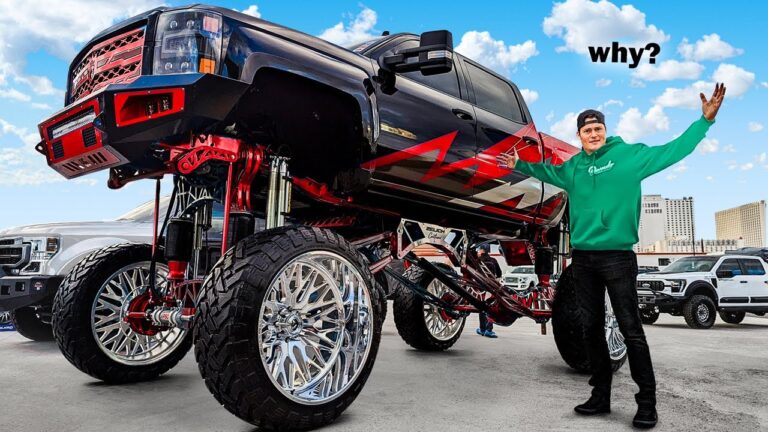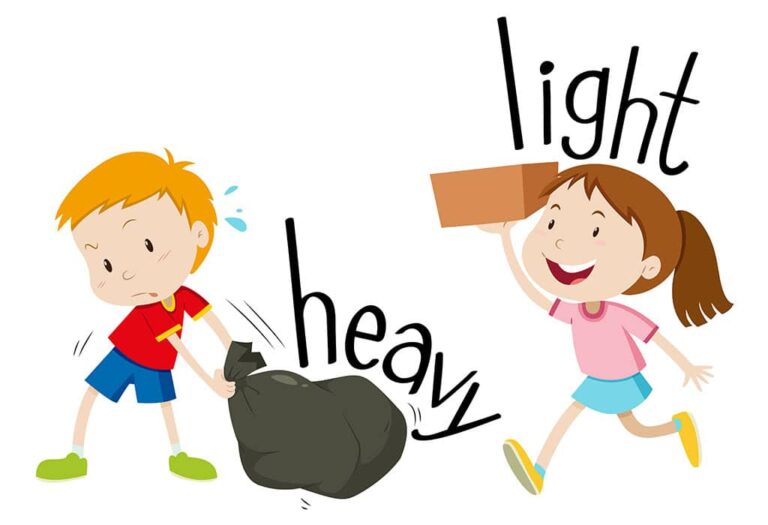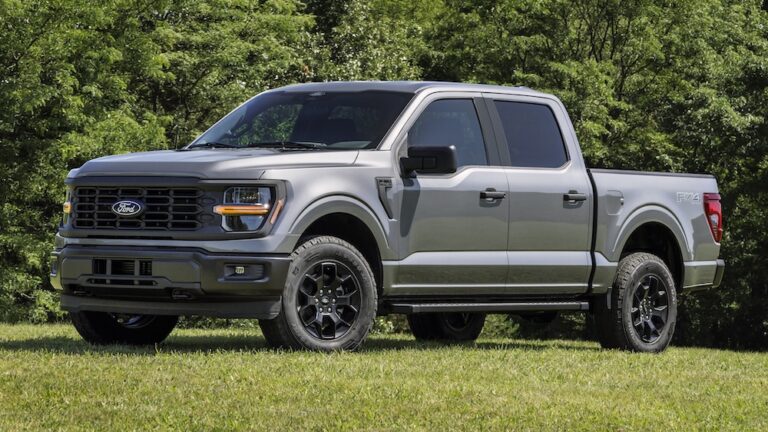Will a Chevy Colorado Topper Fit a 2nd Gen Toyota Tacoma? An In-Depth Guide to Compatibility and Considerations
Will a Chevy Colorado Topper Fit a 2nd Gen Toyota Tacoma? An In-Depth Guide to Compatibility and Considerations cars.truckstrend.com
The allure of a truck topper – also known as a bed cap, shell, or camper shell – is undeniable. It transforms your truck bed into a secure, weather-resistant cargo area, ideal for camping, hauling tools, or simply keeping your gear dry and safe from prying eyes. For truck owners, the prospect of finding a good deal on a used topper can be very appealing. This often leads to a common question: "Will a topper designed for one truck, like a Chevy Colorado, fit another, such as a 2nd Generation Toyota Tacoma?"
This article will comprehensively explore the intricate details of truck topper compatibility, specifically addressing whether a Chevy Colorado topper can be made to fit a 2nd Gen Toyota Tacoma (models produced from 2005 to 2015). While the idea of a universal fit is tempting, the reality is far more complex. Understanding the subtle yet critical differences between truck beds is paramount before investing time, money, and effort into a potentially ill-fitting solution. Our goal is to provide practical advice, detailed comparisons, and actionable insights to help you make an informed decision about securing the perfect topper for your Tacoma.
Will a Chevy Colorado Topper Fit a 2nd Gen Toyota Tacoma? An In-Depth Guide to Compatibility and Considerations
Understanding Truck Bed Dimensions and Why They Matter
At first glance, many mid-size truck beds might appear similar in size and shape. However, this superficial resemblance hides a multitude of crucial dimensional differences that make cross-fitment a significant challenge. Truck manufacturers design their beds with unique specifications, tailored to the vehicle’s frame, cab contour, and overall aesthetic. Even a difference of an inch or less in any dimension can lead to major compatibility issues.
The key dimensions that dictate a topper’s fit include:
- Bed Length: This is the most obvious measurement, from the bulkhead (front of the bed near the cab) to the inside of the tailgate. Toppers are designed for specific bed lengths (e.g., 5-foot, 6-foot). A topper that is too long or too short simply won’t work.
- Bed Width: This is critical and often varies significantly. Measurements are usually taken at three points:
- Bulkhead Width: The width of the bed near the cab.
- Mid-Bed Width: The width in the middle of the bed.
- Tailgate Width: The width at the rear of the bed opening. Many truck beds taper slightly from front to back, or have different flares over the wheel wells.

- Bed Rail Height: The vertical distance from the bed floor to the top of the bed rails. Toppers sit on these rails, and if the topper’s side skirts are too deep or too shallow, they won’t sit flush or seal properly.
- Cab Contour and Bulkhead Angle: The shape and angle of the truck’s rear cab window and the front of the truck bed (bulkhead) are crucial. Toppers are often designed to seamlessly meet the cab, creating an aerodynamic and aesthetically pleasing look. If the angles don’t match, there will be an unsightly gap or interference.
- Tailgate Design: The angle and shape of the tailgate can affect how the rear of the topper closes and seals.
- Bed Rail Caps/Liners: Many trucks have plastic or metal bed rail caps. These add to the overall width and can affect how the topper clamps down and seals.

Any mismatch in these dimensions can lead to an improper fit, resulting in water leaks, dust intrusion, compromised security, poor aesthetics, and even potential damage to the topper or your truck’s bed rails.
Comparing Chevy Colorado and 2nd Gen Toyota Tacoma Bed Dimensions

To understand why a direct swap is unlikely, let’s briefly look at the general characteristics of the bed dimensions for both trucks.
Chevy Colorado (Relevant Generations, e.g., 2004-2012 / 2015-Present Mid-Size)
- Common Bed Lengths: Typically offered in short bed (around 5’2" or 62 inches) and long bed (around 6’2" or 74 inches).
- Widths: Generally, Colorado beds have an inside width around 57-58 inches at the bulkhead and may slightly taper. The bed rail height is also specific to its design.
- Cab Contour: The contour where the topper meets the cab is distinct, designed to flow with the Colorado’s cab lines.
2nd Gen Toyota Tacoma (2005-2015)
- Common Bed Lengths: Offered in short bed (approximately 5′ or 60 inches) and long bed (approximately 6′ or 72 inches).
- Widths: The 2nd Gen Tacoma’s bed width is typically around 53-54 inches inside at the bulkhead, and importantly, it often tapers more significantly towards the tailgate compared to other trucks. The bed rail height is also unique to the Tacoma.
- Cab Contour: The Tacoma’s rear cab window and bulkhead angle are specific to its design, ensuring a flush fit with toppers made for it.
Key Differences and Their Impact:
Even though both are mid-size trucks, their bed dimensions are not interchangeable.
- Length: A 6-foot Colorado topper is often slightly longer than a 6-foot Tacoma bed, and vice-versa for short beds. This alone makes a proper seal impossible.
- Width: The Tacoma’s bed is generally narrower than the Colorado’s, especially at the bulkhead and often tapering differently. This means a Colorado topper would likely overhang the Tacoma’s bed rails, creating massive gaps and an unstable fit. Conversely, a Tacoma topper on a Colorado would be too narrow, leaving large gaps.
- Bed Rail Height & Shape: The height and the specific profile of the bed rails will differ. This impacts how the topper sits and how effectively the clamps can secure it. The Tacoma’s composite bed also presents unique clamping challenges compared to a metal bed.
- Cab Contour: The curve and angle where the topper meets the cab are almost guaranteed not to match between the two trucks. This will result in an unsightly gap, affecting aerodynamics and weather sealing.
The Challenges of Cross-Fitment
Attempting to force a Chevy Colorado topper onto a 2nd Gen Toyota Tacoma bed, or any non-OEM specific topper, presents a myriad of challenges that often outweigh any perceived cost savings.
- Gaps and Sealing Issues: This is the most prevalent problem. Mismatched dimensions lead to unavoidable gaps between the topper and the bed rails, as well as between the topper and the cab. These gaps allow water, dust, and even small pests to enter the bed, compromising the very purpose of a topper. Security is also diminished, as it’s easier to pry open a poorly sealed topper.
- Improper Clamping and Stability: Toppers are secured to the truck bed rails with clamps. If the topper’s frame doesn’t sit flush or the dimensions are off, the clamps won’t be able to achieve a secure grip. This can lead to the topper shifting during driving, causing damage to the topper, the truck’s bed rails, or even posing a safety hazard if it becomes dislodged at speed.
- Aesthetics: An ill-fitting topper looks unprofessional and can detract significantly from the vehicle’s appearance. It won’t sit flush with the cab, will likely overhang or fall short of the bed edges, and just won’t look "right."
- Structural Integrity: If the topper is not properly supported across its base, stress points can develop, leading to cracking or warping of the topper’s frame or fiberglass shell over time.
- Safety Concerns: A topper that isn’t securely fastened is a serious safety risk. It could shift during hard braking or cornering, or even detach completely, endangering other drivers on the road.
- Modification Difficulty and Cost: Making a topper designed for one truck fit another requires significant fabrication skills and specialized tools. This could involve:
- Cutting and Re-fiberglassing: To adjust length or width, or to reshape the front bulkhead or rear tailgate opening. This is a complex process requiring expertise in fiberglass repair, sanding, and painting.
- Adding Shims or Spacers: To address height differences, but this often compromises stability and aesthetics.
- Custom Sealing Solutions: Using excessive amounts of weather stripping or silicone to fill gaps, which is often a temporary and unsightly fix.
- Custom Clamping Systems: Fabricating new brackets or mounting points.
These modifications are often more expensive and time-consuming than the initial savings from acquiring a "free" or cheap topper, and the end result is rarely satisfactory.
Practical Advice: The Right Way to Get a Topper for Your 2nd Gen Tacoma
Given the extensive challenges, the most practical and recommended approach is to acquire a topper specifically designed for your 2nd Gen Toyota Tacoma.
- Buy New: Tailored Fit and Warranty: This is the ideal solution. Manufacturers like ARE, Leer, SnugTop, and others produce toppers specifically for the 2nd Gen Tacoma. These will offer a perfect fit, come with a warranty, and often include features like interior lights, headliners, and various window options. While the initial cost is higher, the peace of mind, perfect seal, and aesthetics are well worth it.
- Buy Used: Verify Compatibility Meticulously: If budget is a concern, the used market can be a great source. However, always ensure the used topper was originally designed for a 2nd Gen Toyota Tacoma (2005-2015) with the correct bed length (5-foot or 6-foot).
- Before purchasing a used topper, measure your truck’s bed precisely. Note the inside length, the width at the bulkhead, the width at the tailgate, and the height of the bed rails.
- Ask the seller for the exact make, model, and year of the truck the topper came off. If possible, measure the topper itself before committing.
- Visually inspect the topper for damage, especially around the base and corners.
- Be wary of sellers claiming "it should fit" or "it’s close enough." For toppers, "close enough" isn’t good enough.
- Consider Different Topper Types:
- Fiberglass: Most common, durable, paint-matched, good insulation.
- Aluminum: Lighter, more utilitarian, often cheaper, but can be less aesthetically pleasing.
- Soft Toppers: Roll-up or folding covers, offer less security but are lightweight and easy to remove. Not a traditional "topper" but an alternative.
- Pop-up/Camping Toppers: Specialized, often more expensive, but provide stand-up room for camping.
- Professional Installation: Even with a perfectly matched topper, professional installation is highly recommended. They ensure proper sealing, secure clamping, and often connect interior lights or other electrical components correctly.
Price Comparison and Options for Truck Toppers
It’s difficult to provide a "price table" for fitting a Colorado topper to a Tacoma, as it’s not a standard service. Instead, here’s a comparative table outlining the typical costs associated with acquiring and fitting truck toppers, including the hidden costs of attempting a cross-fit.
| Option | Description | Estimated Cost Range (USD) | Pros | Cons |
|---|---|---|---|---|
| New Topper (2nd Gen Tacoma Specific) | Custom-built by manufacturers (ARE, Leer, SnugTop) for your Tacoma’s exact bed dimensions. | $1,500 – $4,000+ | Perfect fit, seamless aesthetics, warranty, weather-tight, custom options | Highest initial investment |
| Used Topper (2nd Gen Tacoma Specific) | Pre-owned topper designed specifically for 2005-2015 Toyota Tacoma (matching bed length). | $500 – $1,500 | Significantly more cost-effective than new, good fit if correct model | Limited availability, potential wear/damage, no warranty, may need paint matching |
| Attempting Colorado Topper Cross-Fit | Acquiring a Chevy Colorado topper and trying to modify it to fit a 2nd Gen Toyota Tacoma. | $0 (topper) + $500 – $2,000+ (modifications/repairs) | Potentially "free" initial topper (if acquired for free) | Poor fit, significant aesthetic issues, water/dust leaks, compromised security, structural concerns, high modification effort/cost, potential damage to truck |
| Professional Modification Services | Hiring a specialized custom fabrication shop to alter an ill-fitting topper (e.g., cut/re-fiberglass). | $1,000 – $3,000+ (highly variable based on complexity) | Might achieve a better fit than DIY, professional finish (if done well) | Extremely expensive, no guarantee of perfect result, still involves compromises, finding a shop willing to do it is hard |
| DIY Modification Tools/Materials | Fiberglass repair kits, sealants, shims, clamps, bondo, paint, sanding supplies, cutting tools. | $100 – $500+ | Cheapest attempt at modification, allows for personal learning | Requires significant skill, time, tools; unlikely to achieve professional results; potential for irreversible damage |
Note: Prices are estimates and can vary widely based on location, brand, features, condition (for used), and the complexity of modifications.
Frequently Asked Questions (FAQ)
Q1: Are truck toppers universal or interchangeable between different truck models?
A1: No, truck toppers are generally not universal. Each topper is designed with specific dimensions to fit a particular truck make, model, and bed length. Even minor differences in bed width, length, rail height, or cab contour will prevent a proper fit.
Q2: What’s the biggest issue with trying to cross-fit a topper from one truck (e.g., Chevy Colorado) to another (e.g., 2nd Gen Toyota Tacoma)?
A2: The most significant issues are mismatched bed dimensions (length, width, bed rail height, and cab contour) which lead to poor sealing, gaps, stability problems, and compromised aesthetics.
Q3: Can I modify a topper to fit a different truck?
A3: While technically possible for skilled fabricators, modifying a topper to fit a different truck is complex, costly, and time-consuming. It often involves cutting, re-fiberglassing, painting, and custom sealing, and the results are rarely as good as a purpose-built topper. The expense usually outweighs any initial savings.
Q4: Where can I find a used topper specifically for my 2nd Gen Toyota Tacoma?
A4: Look on online marketplaces (e.g., Facebook Marketplace, Craigslist, eBay), dedicated truck accessory forums, local truck cap dealers (who sometimes take trade-ins), and specialty salvage yards. Always verify the topper’s original truck make, model, and bed length.
Q5: What should I measure on my 2nd Gen Tacoma’s bed before buying a used topper?
A5: You should measure the inside bed length (from bulkhead to tailgate), the inside width at the bulkhead (front of the bed), the inside width at the tailgate, and the vertical height from the bed floor to the top of the bed rails. Compare these to the topper’s internal dimensions.
Q6: Is it safe to drive with an ill-fitting topper?
A6: No, it is not safe. An ill-fitting topper cannot be securely clamped, making it prone to shifting, rattling, or even becoming dislodged during driving, especially at highway speeds or over rough terrain. This poses a significant safety hazard to you and others on the road, and can damage your truck.
Conclusion
The question of whether a Chevy Colorado topper will fit a 2nd Gen Toyota Tacoma is a common one, driven by the desire for cost savings or convenience. However, the definitive answer is no, not without significant and costly modifications that rarely yield a satisfactory result. Truck beds, even among mid-size pickups, are unique in their dimensions, contours, and rail designs.
Attempting to cross-fit a topper from a different make and model will almost certainly lead to a host of problems: unsightly gaps, water and dust leaks, compromised security, and potential safety hazards due to improper fitment and unstable clamping. While the initial thought of repurposing a cheaper or free topper might be appealing, the hidden costs of modifications, potential damage, and the ongoing frustration of a poor fit invariably outweigh any perceived savings.
For your 2nd Gen Toyota Tacoma, the wisest and most practical approach is to invest in a topper specifically designed for its unique bed dimensions. Whether new or a carefully vetted used unit, a proper-fitting topper will provide the security, weather protection, aesthetics, and peace of mind you desire, ensuring your gear stays safe and your truck looks its best for years to come.






